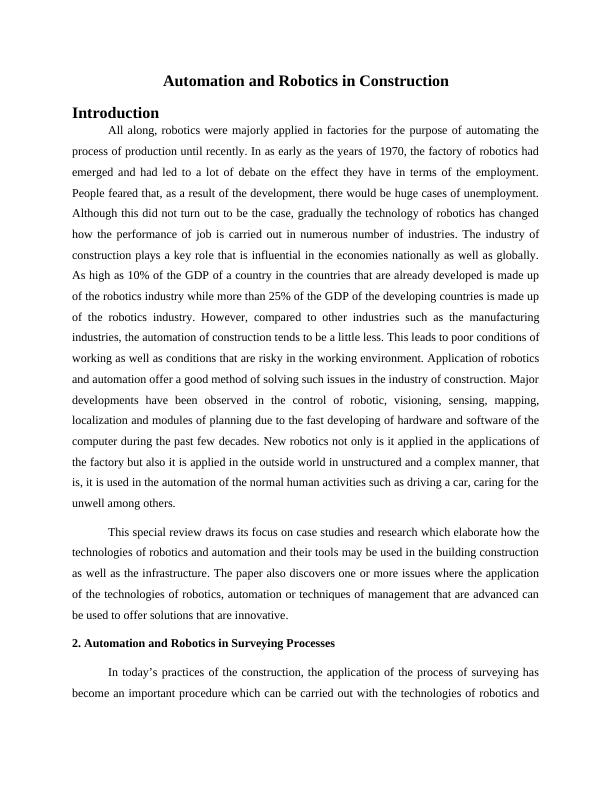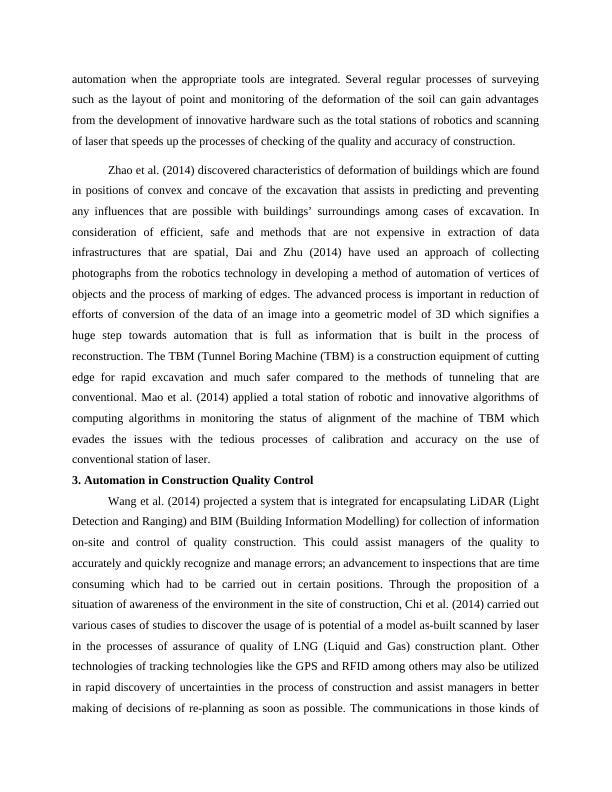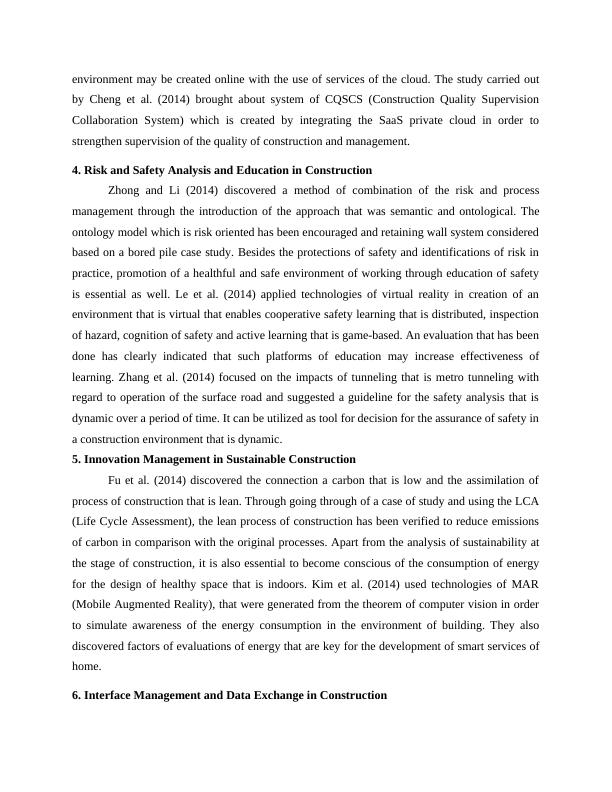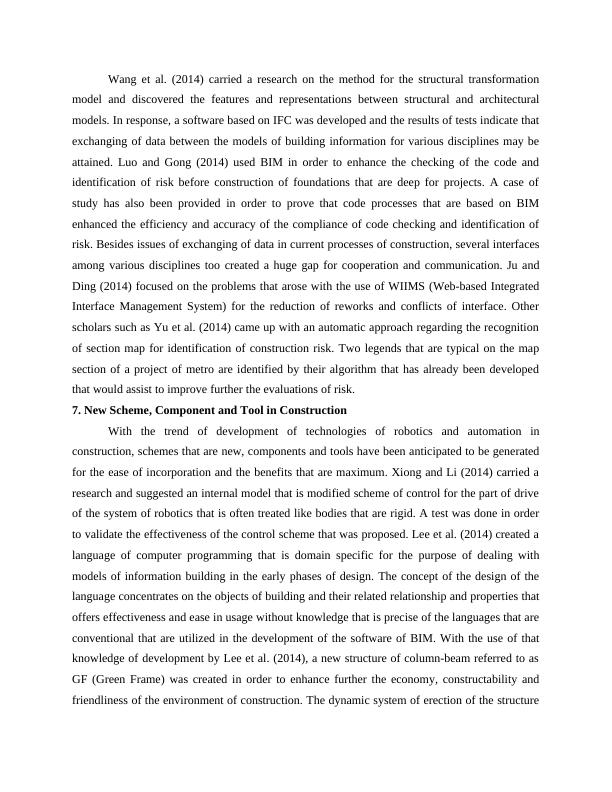Automation and Robotics in Construction: Case Studies and Research
Author a literature review of no less than 3500 words on one of the following topics: Automation and robotics in construction, Business decision making in construction, Cloud computing and construction, Connecting with
12 Pages4659 Words171 Views
Added on 2023-06-11
About This Document
This article explores the benefits of automation and robotics in the construction industry through case studies and research. It covers topics such as surveying processes, quality control, risk and safety analysis, innovation management, data exchange, and new tools and components. The article also discusses the relevance of robotics and automation in the construction industry and the ingredients necessary for successful implementation.
Automation and Robotics in Construction: Case Studies and Research
Author a literature review of no less than 3500 words on one of the following topics: Automation and robotics in construction, Business decision making in construction, Cloud computing and construction, Connecting with
Added on 2023-06-11
ShareRelated Documents
Automation and Robotics in Construction
Introduction
All along, robotics were majorly applied in factories for the purpose of automating the
process of production until recently. In as early as the years of 1970, the factory of robotics had
emerged and had led to a lot of debate on the effect they have in terms of the employment.
People feared that, as a result of the development, there would be huge cases of unemployment.
Although this did not turn out to be the case, gradually the technology of robotics has changed
how the performance of job is carried out in numerous number of industries. The industry of
construction plays a key role that is influential in the economies nationally as well as globally.
As high as 10% of the GDP of a country in the countries that are already developed is made up
of the robotics industry while more than 25% of the GDP of the developing countries is made up
of the robotics industry. However, compared to other industries such as the manufacturing
industries, the automation of construction tends to be a little less. This leads to poor conditions of
working as well as conditions that are risky in the working environment. Application of robotics
and automation offer a good method of solving such issues in the industry of construction. Major
developments have been observed in the control of robotic, visioning, sensing, mapping,
localization and modules of planning due to the fast developing of hardware and software of the
computer during the past few decades. New robotics not only is it applied in the applications of
the factory but also it is applied in the outside world in unstructured and a complex manner, that
is, it is used in the automation of the normal human activities such as driving a car, caring for the
unwell among others.
This special review draws its focus on case studies and research which elaborate how the
technologies of robotics and automation and their tools may be used in the building construction
as well as the infrastructure. The paper also discovers one or more issues where the application
of the technologies of robotics, automation or techniques of management that are advanced can
be used to offer solutions that are innovative.
2. Automation and Robotics in Surveying Processes
In today’s practices of the construction, the application of the process of surveying has
become an important procedure which can be carried out with the technologies of robotics and
Introduction
All along, robotics were majorly applied in factories for the purpose of automating the
process of production until recently. In as early as the years of 1970, the factory of robotics had
emerged and had led to a lot of debate on the effect they have in terms of the employment.
People feared that, as a result of the development, there would be huge cases of unemployment.
Although this did not turn out to be the case, gradually the technology of robotics has changed
how the performance of job is carried out in numerous number of industries. The industry of
construction plays a key role that is influential in the economies nationally as well as globally.
As high as 10% of the GDP of a country in the countries that are already developed is made up
of the robotics industry while more than 25% of the GDP of the developing countries is made up
of the robotics industry. However, compared to other industries such as the manufacturing
industries, the automation of construction tends to be a little less. This leads to poor conditions of
working as well as conditions that are risky in the working environment. Application of robotics
and automation offer a good method of solving such issues in the industry of construction. Major
developments have been observed in the control of robotic, visioning, sensing, mapping,
localization and modules of planning due to the fast developing of hardware and software of the
computer during the past few decades. New robotics not only is it applied in the applications of
the factory but also it is applied in the outside world in unstructured and a complex manner, that
is, it is used in the automation of the normal human activities such as driving a car, caring for the
unwell among others.
This special review draws its focus on case studies and research which elaborate how the
technologies of robotics and automation and their tools may be used in the building construction
as well as the infrastructure. The paper also discovers one or more issues where the application
of the technologies of robotics, automation or techniques of management that are advanced can
be used to offer solutions that are innovative.
2. Automation and Robotics in Surveying Processes
In today’s practices of the construction, the application of the process of surveying has
become an important procedure which can be carried out with the technologies of robotics and

automation when the appropriate tools are integrated. Several regular processes of surveying
such as the layout of point and monitoring of the deformation of the soil can gain advantages
from the development of innovative hardware such as the total stations of robotics and scanning
of laser that speeds up the processes of checking of the quality and accuracy of construction.
Zhao et al. (2014) discovered characteristics of deformation of buildings which are found
in positions of convex and concave of the excavation that assists in predicting and preventing
any influences that are possible with buildings’ surroundings among cases of excavation. In
consideration of efficient, safe and methods that are not expensive in extraction of data
infrastructures that are spatial, Dai and Zhu (2014) have used an approach of collecting
photographs from the robotics technology in developing a method of automation of vertices of
objects and the process of marking of edges. The advanced process is important in reduction of
efforts of conversion of the data of an image into a geometric model of 3D which signifies a
huge step towards automation that is full as information that is built in the process of
reconstruction. The TBM (Tunnel Boring Machine (TBM) is a construction equipment of cutting
edge for rapid excavation and much safer compared to the methods of tunneling that are
conventional. Mao et al. (2014) applied a total station of robotic and innovative algorithms of
computing algorithms in monitoring the status of alignment of the machine of TBM which
evades the issues with the tedious processes of calibration and accuracy on the use of
conventional station of laser.
3. Automation in Construction Quality Control
Wang et al. (2014) projected a system that is integrated for encapsulating LiDAR (Light
Detection and Ranging) and BIM (Building Information Modelling) for collection of information
on-site and control of quality construction. This could assist managers of the quality to
accurately and quickly recognize and manage errors; an advancement to inspections that are time
consuming which had to be carried out in certain positions. Through the proposition of a
situation of awareness of the environment in the site of construction, Chi et al. (2014) carried out
various cases of studies to discover the usage of is potential of a model as-built scanned by laser
in the processes of assurance of quality of LNG (Liquid and Gas) construction plant. Other
technologies of tracking technologies like the GPS and RFID among others may also be utilized
in rapid discovery of uncertainties in the process of construction and assist managers in better
making of decisions of re-planning as soon as possible. The communications in those kinds of
such as the layout of point and monitoring of the deformation of the soil can gain advantages
from the development of innovative hardware such as the total stations of robotics and scanning
of laser that speeds up the processes of checking of the quality and accuracy of construction.
Zhao et al. (2014) discovered characteristics of deformation of buildings which are found
in positions of convex and concave of the excavation that assists in predicting and preventing
any influences that are possible with buildings’ surroundings among cases of excavation. In
consideration of efficient, safe and methods that are not expensive in extraction of data
infrastructures that are spatial, Dai and Zhu (2014) have used an approach of collecting
photographs from the robotics technology in developing a method of automation of vertices of
objects and the process of marking of edges. The advanced process is important in reduction of
efforts of conversion of the data of an image into a geometric model of 3D which signifies a
huge step towards automation that is full as information that is built in the process of
reconstruction. The TBM (Tunnel Boring Machine (TBM) is a construction equipment of cutting
edge for rapid excavation and much safer compared to the methods of tunneling that are
conventional. Mao et al. (2014) applied a total station of robotic and innovative algorithms of
computing algorithms in monitoring the status of alignment of the machine of TBM which
evades the issues with the tedious processes of calibration and accuracy on the use of
conventional station of laser.
3. Automation in Construction Quality Control
Wang et al. (2014) projected a system that is integrated for encapsulating LiDAR (Light
Detection and Ranging) and BIM (Building Information Modelling) for collection of information
on-site and control of quality construction. This could assist managers of the quality to
accurately and quickly recognize and manage errors; an advancement to inspections that are time
consuming which had to be carried out in certain positions. Through the proposition of a
situation of awareness of the environment in the site of construction, Chi et al. (2014) carried out
various cases of studies to discover the usage of is potential of a model as-built scanned by laser
in the processes of assurance of quality of LNG (Liquid and Gas) construction plant. Other
technologies of tracking technologies like the GPS and RFID among others may also be utilized
in rapid discovery of uncertainties in the process of construction and assist managers in better
making of decisions of re-planning as soon as possible. The communications in those kinds of

environment may be created online with the use of services of the cloud. The study carried out
by Cheng et al. (2014) brought about system of CQSCS (Construction Quality Supervision
Collaboration System) which is created by integrating the SaaS private cloud in order to
strengthen supervision of the quality of construction and management.
4. Risk and Safety Analysis and Education in Construction
Zhong and Li (2014) discovered a method of combination of the risk and process
management through the introduction of the approach that was semantic and ontological. The
ontology model which is risk oriented has been encouraged and retaining wall system considered
based on a bored pile case study. Besides the protections of safety and identifications of risk in
practice, promotion of a healthful and safe environment of working through education of safety
is essential as well. Le et al. (2014) applied technologies of virtual reality in creation of an
environment that is virtual that enables cooperative safety learning that is distributed, inspection
of hazard, cognition of safety and active learning that is game-based. An evaluation that has been
done has clearly indicated that such platforms of education may increase effectiveness of
learning. Zhang et al. (2014) focused on the impacts of tunneling that is metro tunneling with
regard to operation of the surface road and suggested a guideline for the safety analysis that is
dynamic over a period of time. It can be utilized as tool for decision for the assurance of safety in
a construction environment that is dynamic.
5. Innovation Management in Sustainable Construction
Fu et al. (2014) discovered the connection a carbon that is low and the assimilation of
process of construction that is lean. Through going through of a case of study and using the LCA
(Life Cycle Assessment), the lean process of construction has been verified to reduce emissions
of carbon in comparison with the original processes. Apart from the analysis of sustainability at
the stage of construction, it is also essential to become conscious of the consumption of energy
for the design of healthy space that is indoors. Kim et al. (2014) used technologies of MAR
(Mobile Augmented Reality), that were generated from the theorem of computer vision in order
to simulate awareness of the energy consumption in the environment of building. They also
discovered factors of evaluations of energy that are key for the development of smart services of
home.
6. Interface Management and Data Exchange in Construction
by Cheng et al. (2014) brought about system of CQSCS (Construction Quality Supervision
Collaboration System) which is created by integrating the SaaS private cloud in order to
strengthen supervision of the quality of construction and management.
4. Risk and Safety Analysis and Education in Construction
Zhong and Li (2014) discovered a method of combination of the risk and process
management through the introduction of the approach that was semantic and ontological. The
ontology model which is risk oriented has been encouraged and retaining wall system considered
based on a bored pile case study. Besides the protections of safety and identifications of risk in
practice, promotion of a healthful and safe environment of working through education of safety
is essential as well. Le et al. (2014) applied technologies of virtual reality in creation of an
environment that is virtual that enables cooperative safety learning that is distributed, inspection
of hazard, cognition of safety and active learning that is game-based. An evaluation that has been
done has clearly indicated that such platforms of education may increase effectiveness of
learning. Zhang et al. (2014) focused on the impacts of tunneling that is metro tunneling with
regard to operation of the surface road and suggested a guideline for the safety analysis that is
dynamic over a period of time. It can be utilized as tool for decision for the assurance of safety in
a construction environment that is dynamic.
5. Innovation Management in Sustainable Construction
Fu et al. (2014) discovered the connection a carbon that is low and the assimilation of
process of construction that is lean. Through going through of a case of study and using the LCA
(Life Cycle Assessment), the lean process of construction has been verified to reduce emissions
of carbon in comparison with the original processes. Apart from the analysis of sustainability at
the stage of construction, it is also essential to become conscious of the consumption of energy
for the design of healthy space that is indoors. Kim et al. (2014) used technologies of MAR
(Mobile Augmented Reality), that were generated from the theorem of computer vision in order
to simulate awareness of the energy consumption in the environment of building. They also
discovered factors of evaluations of energy that are key for the development of smart services of
home.
6. Interface Management and Data Exchange in Construction

Wang et al. (2014) carried a research on the method for the structural transformation
model and discovered the features and representations between structural and architectural
models. In response, a software based on IFC was developed and the results of tests indicate that
exchanging of data between the models of building information for various disciplines may be
attained. Luo and Gong (2014) used BIM in order to enhance the checking of the code and
identification of risk before construction of foundations that are deep for projects. A case of
study has also been provided in order to prove that code processes that are based on BIM
enhanced the efficiency and accuracy of the compliance of code checking and identification of
risk. Besides issues of exchanging of data in current processes of construction, several interfaces
among various disciplines too created a huge gap for cooperation and communication. Ju and
Ding (2014) focused on the problems that arose with the use of WIIMS (Web-based Integrated
Interface Management System) for the reduction of reworks and conflicts of interface. Other
scholars such as Yu et al. (2014) came up with an automatic approach regarding the recognition
of section map for identification of construction risk. Two legends that are typical on the map
section of a project of metro are identified by their algorithm that has already been developed
that would assist to improve further the evaluations of risk.
7. New Scheme, Component and Tool in Construction
With the trend of development of technologies of robotics and automation in
construction, schemes that are new, components and tools have been anticipated to be generated
for the ease of incorporation and the benefits that are maximum. Xiong and Li (2014) carried a
research and suggested an internal model that is modified scheme of control for the part of drive
of the system of robotics that is often treated like bodies that are rigid. A test was done in order
to validate the effectiveness of the control scheme that was proposed. Lee et al. (2014) created a
language of computer programming that is domain specific for the purpose of dealing with
models of information building in the early phases of design. The concept of the design of the
language concentrates on the objects of building and their related relationship and properties that
offers effectiveness and ease in usage without knowledge that is precise of the languages that are
conventional that are utilized in the development of the software of BIM. With the use of that
knowledge of development by Lee et al. (2014), a new structure of column-beam referred to as
GF (Green Frame) was created in order to enhance further the economy, constructability and
friendliness of the environment of construction. The dynamic system of erection of the structure
model and discovered the features and representations between structural and architectural
models. In response, a software based on IFC was developed and the results of tests indicate that
exchanging of data between the models of building information for various disciplines may be
attained. Luo and Gong (2014) used BIM in order to enhance the checking of the code and
identification of risk before construction of foundations that are deep for projects. A case of
study has also been provided in order to prove that code processes that are based on BIM
enhanced the efficiency and accuracy of the compliance of code checking and identification of
risk. Besides issues of exchanging of data in current processes of construction, several interfaces
among various disciplines too created a huge gap for cooperation and communication. Ju and
Ding (2014) focused on the problems that arose with the use of WIIMS (Web-based Integrated
Interface Management System) for the reduction of reworks and conflicts of interface. Other
scholars such as Yu et al. (2014) came up with an automatic approach regarding the recognition
of section map for identification of construction risk. Two legends that are typical on the map
section of a project of metro are identified by their algorithm that has already been developed
that would assist to improve further the evaluations of risk.
7. New Scheme, Component and Tool in Construction
With the trend of development of technologies of robotics and automation in
construction, schemes that are new, components and tools have been anticipated to be generated
for the ease of incorporation and the benefits that are maximum. Xiong and Li (2014) carried a
research and suggested an internal model that is modified scheme of control for the part of drive
of the system of robotics that is often treated like bodies that are rigid. A test was done in order
to validate the effectiveness of the control scheme that was proposed. Lee et al. (2014) created a
language of computer programming that is domain specific for the purpose of dealing with
models of information building in the early phases of design. The concept of the design of the
language concentrates on the objects of building and their related relationship and properties that
offers effectiveness and ease in usage without knowledge that is precise of the languages that are
conventional that are utilized in the development of the software of BIM. With the use of that
knowledge of development by Lee et al. (2014), a new structure of column-beam referred to as
GF (Green Frame) was created in order to enhance further the economy, constructability and
friendliness of the environment of construction. The dynamic system of erection of the structure

End of preview
Want to access all the pages? Upload your documents or become a member.
Related Documents
Design of an Autonomous Agricultural Robot for Navigation Between Rowslg...
|12
|2928
|332
Prefabrication Course 2022lg...
|10
|2534
|18
How do I write all three career episodes for CDR?lg...
|6
|1725
|17
Analyzing and Evaluating Faults in Dynamic Control Management Systemslg...
|25
|7326
|453
Prefabrication: A Research Paper on Fabricationlg...
|23
|6064
|461
Proposed Industrial Park Project: Construction Industry Development, Company Structures, and Contract Typeslg...
|19
|4911
|499
